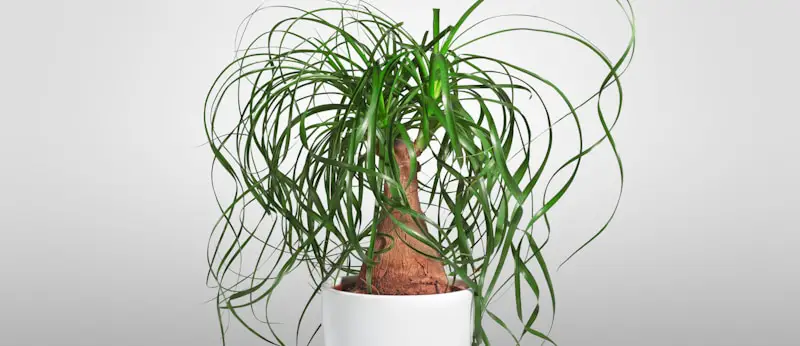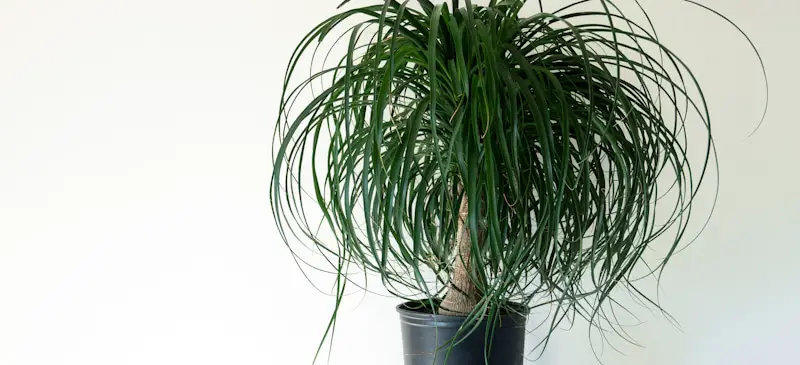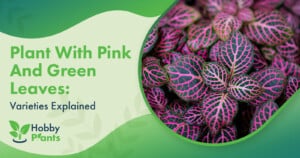Ponytail palms are a fantastic indoor houseplant option since they’re easy to take care of, look incredibly striking, and can reside for a long time. Still, one of the frequent problems with the plant is the tips becoming brown. Honestly, multiple reasons are not always easy to sort out.
So, what causes brown tips on a ponytail palm? The most common cause is overwatering. However, plenty of different factors can become the most critical factor. Insufficient light, the wrong soil in a defective pot, underwatering, or excessive compost are all contributing aspects.
On the off chance that you observe brown tips on your ponytail palm, it might require an investigation to sort out the exact cause of the issue simultaneously. As a rule, rectifying the problem is easy. Read on to learn everything you can to keep your ponytail plant luscious and healthy.

What Causes Brown Tips on A Ponytail Palm?
Brown tips aren’t strange for ponytail palms; however, the cause isn’t upfront at all times. Brown tips can happen from a solitary issue or a combination of factors. Once in a while, the solution is relatively easy. Yet, it can take a long time to work out what to do if you don’t have experience. So, here are the absolute most common offenders.
Overwatering
Overwatering is the most frequent reason for brown leaf tips in a ponytail palm plant. To give you some context, the ponytail palm plant originates from the arid and warm region of East Mexico. Since rainfall isn’t that common there, plants that develop here have many extraordinary traits that allow them to live in these rough conditions and flourish in them.
Consequently, the traits that assist these plants with flourishing in the dry, hot weather of East Mexico are the same ones that result in issues when you keep them as houseplants.
The ponytail palm has to depend on its strong, robust underground root growth to make due in the desert. The roots absorb and store what scarce water is obtainable and hold on to it for extended timeframes. When the plant gets too much water, the roots become over-soaked and begin to show injury, including – you guessed it – browning of the leaves.
Assuming overwatering is the issue, you can see that the container for the plant turns out to be delicate and soft. The roots can also start to deteriorate and foster root decay. Suppose you don’t alter your watering routine when these danger signs appear. In that case, your precious ponytail palm can eventually wither away.
There are rules to observe regarding when and how much you water to prevent these problems and maintain your ponytail palm plant’s health. That can be somewhat difficult because the amount of water you provide for your ponytail relies upon several factors. That includes how much light it gets, how large it is, and the consistency and combination of its dirt.
You should also keep the room temp, container size, and the frequency of your plant watering and care in mind. To make that a little easier, we should look at each aspect to comprehend what is best for a ponytail palm plant.
Underwatering
On the conflicting side of the spectrum, you can expect brown tips on ponytail palms to underwatering. Although adaptable to times of dry spell, even a hardy plant has its cut-off points.
If you leave a ponytail palm without water for some time, it can end up sickly, and the tips of the leaf can become brown and bite the dust. Although that can affect the look of a ponytail palm, remember that it is only a survival device. The plant focuses on keeping its dominant tissues hydrated at the cost of the leaf tips.
Distinguishing underwatering is easy when you feel the dirt since it can be as dry as residue. The pot can also appear light because of the lack of water. Meanwhile, the earth can feel drier from the base to the top. All these signs indicate that your plant hasn’t been getting enough water to sustain its health.
You can fix that issue by watering your plant thoroughly and saturating the dirt. Most people frequently take a plant like a ponytail palm to a sink to water it from the top while allowing the sink partly to load up with water for a couple of moments. That gives the plant extra opportunity to absorb the available water.
Ensure you drain the plant well after a few moments so the dirt isn’t left wet. Don’t start over watering your plant to compensate for underwatering. Continue a regular watering schedule, checking the plant and soil like clockwork and waiting until the top two or three inches of the earth dry before watering some more.

Inadequate Light
Regarding light, the ponytail palm requires a lot of it and flourishes when presented to it for extended time frames. Placing your ponytail palm in a sufficiently bright spot is easy to ensure it thrives. You don’t have to overdo it and worry about ensuring each leaf gets sufficient light since it’s as much as possible.
There can be times throughout the cold weather months when the light won’t be as consistent. However, it should be sufficient for the ponytail palm, thanks to its durable nature. Once in a while, individuals can keep their ponytails outside throughout the late spring months.
That is useful as it allows the plant to store unreasonable amounts of energy from the light for use over the approaching winter. While it is undoubtedly beneficial, doing so is not necessary.
In rare cases, excessive daylight can cause the ponytail to foster brown tips. Still, that is usually the aftereffect of too much light alongside practically no water for a lengthy time frame. To visualize these impacts, you must go without watering your plant for long periods.
Soil And Compost Issues
A combination of sand, perlite, and regular fertilized soil is the finest dirt blend for the ponytail palm to make it easier to avoid brown leaf tips. Use enough ground in the pot till you have space at the top and around the edges. It would be best if you also ensure that the container has drainage openings in the base so any overabundance of water can leak out safely.
The stem of the plant should stay above the dirt line. If it’s covered, the trunk can, without a doubt, spoil. You should pick the pot size depending on the size of the plant and the room temperature, which should be somewhere between 60 and 80 F.
Finally, you don’t need compost, yet adding a little in the spring and maybe once in the mid-year can assist a malnourished plant with recuperating. Over-treating can cause the leaf tips to brown, so use compost sparingly and only add about a fourth of what the directions suggest.
Remember that your soil and compost are just one factor in a ponytail palm’s health. You can have the right dirt combo and compost concentration. Still, the nutrition won’t make a difference without the appropriate amount of light and water. It would be best to balance these factors simultaneously to ensure your plant grows properly without any brown tips or other issues.
Final Words
Hopefully, now you have a more comprehensive understanding of the causes of brown tips in ponytail palm plants. You must mainly focus on the amount and frequency of watering, light, soil, and compost. Once you figure out what’s causing your plant’s tips to turn brown, you can deal with that specific issue. Good luck!
Victoria is the owner and main author of hobby plants. She loves spending her free time in her garden planting and taking care of her plants. Victoria hopes you enjoy the content here!
![Why Does My Majesty Palm Have Brown Tips? [EXPLAINED] Why Does My Majesty Palm Have Brown Tips? [EXPLAINED]](https://www.hobbyplants.com/wp-content/uploads/2022/08/majesty-palm-brown-tips-300x158.jpg)
![Why Are My Peace Lily Leaves Turning Brown? [EXPLAINED] Why Are My Peace Lily Leaves Turning Brown? [EXPLAINED]](https://www.hobbyplants.com/wp-content/uploads/2022/07/peace-lily-leaves-turning-brown-1-300x158.jpg)
![Why Is My Aloe Plant Turning Brown? [FIND OUT HERE] Why Is My Aloe Plant Turning Brown? [FIND OUT HERE]](https://www.hobbyplants.com/wp-content/uploads/2022/07/why-is-my-aloe-plant-turning-brown-300x158.jpg)
![Prayer Plant At Night: What Makes Them Unique? [EXPLAINED] Prayer Plant At Night: What Makes Them Unique? [EXPLAINED]](https://www.hobbyplants.com/wp-content/uploads/2022/07/prayer-plant-at-night-300x158.jpg)
![Best Soil For A Money Tree? [DIFFERENCES EXPLAINED] Best Soil For A Money Tree? [DIFFERENCES EXPLAINED]](https://www.hobbyplants.com/wp-content/uploads/2022/08/best-soil-for-money-tree-300x158.jpg)

![The Types of Prayer Plants: [Varieties Explained] The Types of Prayer Plants: [Varieties Explained]](https://www.hobbyplants.com/wp-content/uploads/2022/09/types-of-prayer-plants-300x158.jpg)
![The Types of Ice Plants: [Varieties Explained] The Types of Ice Plants: [Varieties Explained]](https://www.hobbyplants.com/wp-content/uploads/2022/09/types-of-ice-plant-300x158.jpg)
![What Are Ground Cover Plants? [Varieties Explained] What Are Ground Cover Plants? [Varieties Explained]](https://www.hobbyplants.com/wp-content/uploads/2022/08/ground-cover-plants-300x158.jpg)
![Majesty Palm Plant Care: [Complete Beginner's Guide] Majesty Palm Plant Care: [Complete Beginner's Guide]](https://www.hobbyplants.com/wp-content/uploads/2022/08/majesty-palm-care-300x158.jpg)